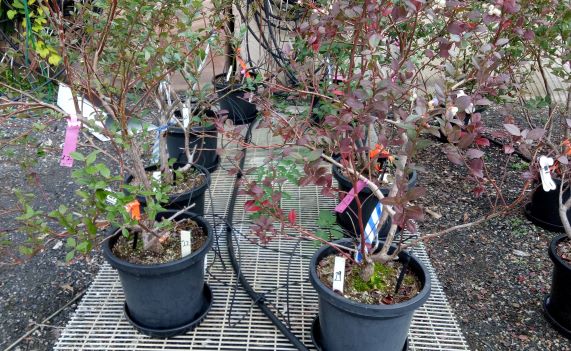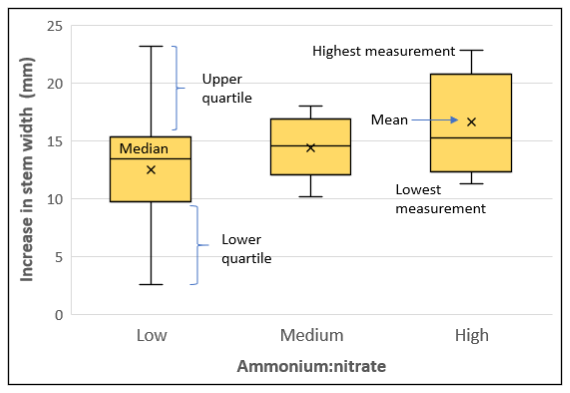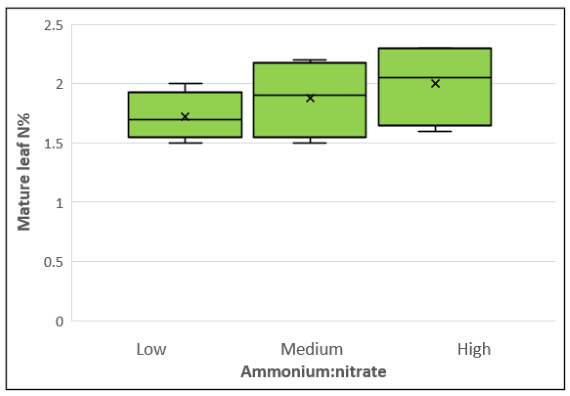
Blueberry Nutrition: The Right Nitrogen Source
A CCC Insight from Dr Sophie Parks, NSW Department of Primary Industries Senior Research Scientist
- Blueberry plants like nitrogen in the forum of ammonium
- Blueberry plants do not take up more ammonium than they need
- Excess ammonium in the rootzone can become nitrogen pollution in soil run-off
The current NSW Department of Primary Industries (DPI) recommendation for nitrogen fertiliser application in fertigated blueberry production is a rate of no more than 100-121 kg of nitrogen (N) per hectare per year.
This annual rate, split into weekly applications, is recommended for a mature planting of fertigated blueberries grown in soil, using a plant density of approximately 3500 plants per hectare.
In a well-designed system, fertigation (the delivery of fertiliser in solution via irrigation) can direct nutrients into the root zone to meet the demands of plant growth.
Growers are encouraged to adopt the 4Rs approach to plant nutrition to improve the nitrogen-use efficiency of this recommended fertigation rate, while fully meeting the plant’s nitrogen requirements:
- right source – the fertiliser type the plant requires
- right rate – how much the plant requires
- right time – when the plant requires it
- right place – where the plant requires it
In this article we are focusing on the first R, the 'right source' of nitrogen for blueberries.
Blueberry plants have an appetite for ammonium as a nitrogen source
Plants can take up nitrogen in the form of nitrate and ammonium. These forms of nitrogen are charged chemical compounds represented by the symbols NO3- and NH4+ respectively. Most plants prefer nitrate, as ammonium isn't easily stored in plant tissue, however there are some plants, such as the blueberry, that respond well to ammonium included in their nitrogen fertiliser regime.
Overseas research has shown that the vegetative growth of blueberry crops is greater when an ammonium source of nitrogen fertiliser is used. Similarly, our NSW DPI Clean Coastal Catchments funded research in northern NSW, has shown a small trend of increased plant growth in response to a higher proportion of nitrogen supplied as ammonium, despite all plants in the trial receiving the same total amount of nitrogen (Figure 1). A small trend of increased total nitrogen concentration in leaves was also observed (Figure 2).
How to interpret box plots:
Data are sorted from lowest to highest and separated into four quartiles. In each box, the cross represents the average or mean increase in stem width within each treatment (low, medium or high), in this case for 11 plants. The box contains the middle two quartiles of the observations with the box ends representing the upper and lower quartile measurements for increase in stem width. The ends of the ‘whiskers’ indicate the highest and lowest measurements, while the horizontal line in the box is the median (middle) measurement for increase in stem width.
The positive response of blueberry to an ammonium source applied as a foliar spray is obvious in the greener leaves pictured in Figure 3, compared to the red leaves of plants sprayed with water.
However, nitrate cannot be ignored as a nitrogen source for blueberry, as uptake of nitrogen via roots and shoots has been demonstrated in previous studies. Research by the Clean Coastal Catchments team continues to improve our understanding of blueberry responses to both ammonium and nitrate in evergreen growing systems.

Appropriate sources of ammonium fertiliser for blueberry
Urea is commonly used as a source of nitrogen for fertigated crops. Urea forms ammonium when it is broken down or ‘hydrolysed’ in the soil solution, creating an ideal nitrogen source for blueberry. Evidence also suggests plant roots can take up urea directly from the root zone solution.
Urea can also be applied as a foliar spray on the blueberry canopy to alleviate symptoms in nitrogen-deficient plants. Current research aims to understand how this practice contributes to the nitrogen status of the plant. However, when applying foliar urea, ensure to select a low biuret grade as biuret is potentially phytotoxic and can cause leaf burn.
Other ammonium fertilisers can be used in fertigation when the crop requires sulfur or phosphorus. These include ammonium sulfate (sulfate of ammonia) for supplying sulfur, and mono ammonium phosphate (MAP) for supplying phosphorous. Keep in mind that the proportion of sulfur and phosphorus in these fertilisers exceeds the proportion of nitrogen, yet plant demand for nitrogen will always exceed demand for sulfate and phosphorus, so an additional source of nitrogen will be required for optimal plant growth.
Caution is required in the application of ammonium fertilisers as they can contribute to soil acidification. Ammonium sulfate is more acidifying than ammonium phosphate, however it is important to note that other forms of fertiliser can also cause acidification.
Although blueberry plants prefer an acid soil range of pH 4.2-5.5 (as measured in a water and soil solution), unless soil pH is above 5, we recommend avoiding ammonium sulfate, based on overseas data. Soil acidity should be monitored through regular pH testing.
Over fertilisation: when ammonium can become nitrate
The key to optimal nutrition is to supply small amounts of fertiliser often to meet plant demand. Imagine if you presented your dog or cat with a month’s supply of dinners in the one sitting. Although some pets may try, they would not be able to eat everything and much of the food would be wasted!
Similarly, research has shown that when provided in excess, a blueberry plant will not take up more ammonium through its roots than it needs. The danger is that the remaining ammonium in the root zone will be utilised by bacteria causing nitrification, a process that results in the formation of nitrate. The nitrate formed through this process is unlikely to be taken up by the blueberry roots and can easily move down the soil profile with the next rainfall event or irrigation application, contributing to nitrogen pollution in water ways.
Nitrification is also associated with rapid acidification of the soil or substrate, which can reduce the availability of some essential nutrients in the soil.
Blueberry in potted substrate
For blueberry plants grown in substrate, nutrient solutions are delivered in fertigation to provide complete nutrition. Unlike a soil system, little nutrition is provided by the substrate and there is currently little understanding of how blueberry plants function within this type of system.
Research is ongoing to increase our understanding of plant growth in substrate and to enable the re-use of nutrients in leachate. We are also working to develop appropriate nutrient formulations and production guidelines that will optimise nitrogen nutrition in substrate systems while minimising nitrification in the root zone.
The Clean Coastal Catchments project is also investigating seasonal plant demand for nitrogen and other nutrients in evergreen blueberry crops, to address the ‘right rate’ and ‘right time’ aspects of the 4Rs. Further nutrition guideline fact sheets looking at nutrition rates and timing will be released over the next twelve months.
The Clean Coastal Catchments project is funded by the NSW Government through the Water Quality Initiative of the Marine Estate Management Strategy. The ten-year Strategy was developed by the NSW Marine Estate Management Authority to coordinate the management of the marine estate.
This article was written by Dr Sophie Parks for the NSW DPI Clean Coastal Catchments project and originally published in Soilless Australia Magazine - Spring Edition 2021.



